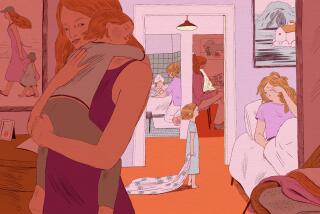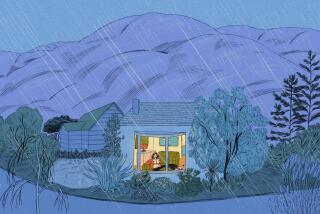Op-Ed: Why do we make children sleep alone?

Instead of giving children their own room, sleeping in close proximity to them may be a more enlightened, sustainable use of space and natural resources.
One particularly strange feature of middle-class family life is the way we train our children to sleep. “Go to your room,” we tell even very young children, “and stay there all night.” We have invented elaborate techniques to support this supposedly essential aspect of child development, implementing them at great emotional cost to all parties involved. For the parents: agonizing decisions about when and whether to comfort a crying child, bleary-eyed squabbles about which parent takes a turn in the middle of the night. For the kids: fear of being alone in the dark, and resentment of the adults who, in the words of historian Peter Stearns, “hovered about urging sleep when none was wanted.” The resulting frustration seems to have reached a boiling point, as evidenced by the best-selling mock-bedtime book, “Go the F— to Sleep.”
Why do we do it?
For all the tenacity with which we cling to the ideal of solitary childhood sleep, it’s a historical anomaly. This system of sleeping — adults in one room, each child walled off in another — was common practice exactly nowhere before the late 19th century, when it took hold in Europe and North America. Even in wealthy families that could afford to spread out, children generally slept in the same room with nurses or siblings. Indeed, solitary childhood sleep seems cruel in those parts of the world where co-sleeping is still practiced, including developed countries such as Japan.
But as industrial wealth spread through the Western economies, so did a sense that individual privacy — felt most intently at night — was a hallmark of “civilization.” Great pains were taken to relieve nighttime overcrowding and provide more privacy in factory boardinghouses, which were thought to breed disease and immorality through the proximity of sleeping bodies. In an 1842 report, the pioneering English health reformer Edwin Chadwick wrote that, “in such facilities two or three families would sleep together, workers coughing and snoring together in rooms without windows or chimneys, the whole atmosphere pervaded by filth, fetid air and vice.” In response to these conditions, in 1851, Parliament passed a Common Lodging Houses Act specifying, among other health measures, the need for basic privacy.
Spreading out requires large homes that are expensive to build, to heat and to power with electricity. Our sleep ... has a large carbon footprint.
Ensuring privacy at night was not just a health concern; it was also a matter of defining proper “whiteness” or “Europeanness.” While reformers endorsed solitary sleep as healthful and moral, they noted that “savages” slept collectively — and this practice was somehow to blame for underdevelopment of the non-Western world.
According to the physician William Whitty Hall, author of a popular 19th century sleep hygiene book, individuals in co-sleeping societies were like “wolves, hogs and vermin” who “huddle together,” whereas in the civilized West, “each child, as it grows up, has a separate apartment.” Where social sleeping persisted among white people, it was usually associated with poverty and considered a social ill — as in Jacob Riis’s 1890 “How the Other Half Lives.” One hundred and fifty tenement dwellers, he observed with horror, slept “on filthy floors in two buildings,” and tramps dozed off in the doorways.
This new insistence on individual sleeping was reinforced in psychology and pediatrics through the 20th century. In 1928, the behavioral psychologist John Watson argued that children should occupy their own rooms as early as possible for fear that too much coddling would stunt a child’s development. Sigmund Freud’s Oedipal complex — with its nightmarish vision of children permanently scarred by witnessing parental sex — gave impetus to the idea that nighttime proximity was harmful. The most famous pediatrician of the mid-20th century, Benjamin Spock, offered a mélange of Freudian ideas and behavioral training, warning that “the young child may be upset by the parents’ intercourse, which he misunderstands and which frightens him.” To prevent this traumatic outcome, Spock recommended trapping the child in the crib with an adapted badminton net.
The best-known method for separating children from parents involves training rather than webbing. “Bedtime means separation,” wrote Dr. Richard Ferber in 1985, because learning to sleep apart from parents allows the child “to see himself as an independent individual.” Ferber later backed off the claim that solitary sleep was universally preferable to co-sleeping and acknowledged that “co-sleeping predominated as our species evolved.” He instead counseled parents to “choose whichever system best suits you.” But he loaded the dice, reminding readers that co-sleeping societies tend to “remain socially and economically most ‘primitive’” — perhaps unintentionally echoing old associations of collective sleeping with supposedly inferior cultures.
There are, of course, good reasons for children to have their own bedrooms. It’s more practical for adults to pursue nighttime leisure in an area where children aren’t sleeping; it’s easier to set everyone on a proper schedule for work and school when they can all retire to different spaces at different times; and parental intimacy may increase without little ones around. Doctors advise parents not to share soft mattresses with infants — in case they roll over and suffocate the child — especially if the adults have been drinking before bed.
Tell us: What’s the sleeping arrangement in your house? »
I should also admit that I raised my kids to sleep alone. At the time, there seemed to be no reasonable alternative. But in fact there are economic, environmental and emotional benefits of sleeping together. Spreading out requires large homes that are expensive to build, to heat and to power with electricity. Our sleep, in other words, has a large carbon footprint. Far from being a backward practice, co-sleeping, or at least sleeping in close proximity, may be a more enlightened, sustainable use of space and natural resources.
The most obvious benefit might be knocking down the figurative walls that separate us. By the time we get the kids to stay in their rooms, they never want to let us back in, and “get out of my room!” replaces “go the f— to sleep!” as the American “goodnight.”
By contrast, as anthropologists Carol Worthman and Ryan Brown have argued, family structures in co-sleeping societies tend to be closer-knit, with less intergenerational conflict. Increased spousal tension is another likely byproduct of solitary sleep: How can kids brought up to think of the bedroom as a private fortress be expected, when they grow up, to tolerate someone else snoring, rolling over, playing with a phone, or taking a trip to the bathroom in the middle of the night? It’s no surprise that more and more home buyers are requesting separate master bedrooms, which in turn will require suburbanites to give their McMansions another shot of steroids.
If we raised our children to share space with each other and their parents at night, they might grow up to fight a bit less, share a bit more, and care for others as much as they care for themselves.
Benjamin Reiss is a professor of English at Emory University. He is the author most recently of “Wild Nights: How Taming Sleep Created Our Restless World.”
Follow the Opinion section on Twitter @latimesopinion or Facebook.
ALSO
Just like her mother, Chelsea Clinton never gets a break
More to Read
A cure for the common opinion
Get thought-provoking perspectives with our weekly newsletter.
You may occasionally receive promotional content from the Los Angeles Times.










